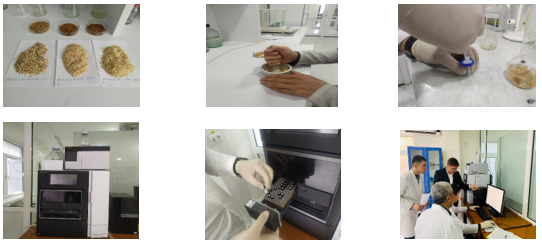
The Importance of the High-Efficiency Liquid Chromatography Method and the Structure of the Device – A very small sample of the sample to be separated and tested is passed through a column into a portable phase stream. There are different types of columns available with sorbents of different particle sizes and surfaces. The mixture moves along the column at different speeds and interacts with the sorbent, also known as the stable phase. The velocity of each component in the mixture depends 1) on its chemical properties, 2) on the nature of the column, and 3) on the composition of the mobile phase. Different substances are separated from the column at different times over a period of time. Storage time is measured under specific conditions and is considered a specific feature of a particular device.

Amygdalin – is one of the natural cyanogenic glycosides present in the seeds of apricots, apples, black cherries, peaches, plums and others. Cyanogenic glycosides are phytotoxins produced by HCN; HCN is a powerful and fast-acting poison, even a small amount of it is very harmful. Exceeding the prescribed amount can lead to death. Amygdalin can be up to the above values according to the navigation of plants listed almond, apricot (14 g / kg), peach (6.8 g / kg) and plum (4 – 17.5 g / kg).

Toxins are toxins that are formed during the life of microorganisms. It has the property of infecting or killing animals and humans when it enters the body. They are available in types such as toxin T2, oxratoxin, aflatoxin B1, B2 G1, G2 and zearalenone. The effects of toxins on cells are described

Aflatoxins are carcinogenic substances produced naturally by bacteria and fungi that are known to contaminate a variety of foods in humans and animals. Aflatoxins have been found to cause unpleasant diseases such as liver cancer, child growth disorders, and decreased immunity.

Vitamins are medicines- organic compounds necessary for the vital functions of a living organism and normal metabolism. They have different chemical structures. Vitamins A, B, C, and D, which are of great practical importance, are the most studied.

Amino acids areorganic compounds with amine and carboxyl groups in their molecules, which are the basic elements of plant and animal protein. Amino acids are colorless, water-soluble crystalline substances. 200 natural amino acids are known. But proteins contain only 20 different amino acids and their two amides. Twenty amino acids are involved in protein synthesis. Proteins are classified according to their biological functions: enzymes (trypsin, ribonuclease), carrier proteins. (hemoglobin, serum albumin, myoglobin), food and reserve proteins (egg albumin, casein in milk, ferritin), contractile and action proteins (actin, myosin), structural proteins (collagen, proteoglycans, creatine), protective proteins (antibodies, fibrinogen, thrombin, snake venom, arthritis toxin), control proteins (insulin, corticotropin, growth hormone), and more.

Pesticides aretoxic chemicals used to control plant pests and diseases, weeds, as well as wood, cotton fiber products, wool, skin pests, and pets. Auxins, gibberellins, defoliants, desiccants, retradants are also included in pesticides. Pesticides enter the cells of living organisms and change their physical and chemical properties. It chemically reacts with proteins and other substances in the cell to precipitate them, weakens the activity of enzymes, disrupts the metabolic process, and destroys the cell.

Gossipol, C30H30O8 is a yellow toxic, hard crystalline substance. Polyphenols are compounds. It is abundant in cottonseed and Iddiz husks (0.02-1.6%) and low in other parts. Gossypol and its analogues – gossipurpurine, gossiverdurin, gossifulvin – are located in special glands in the seed nucleus, the walls of which are extremely strong and resistant to most organic solvents.
